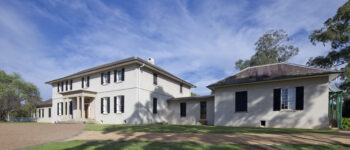1840: The Treaty of Poihakena
February 15, 2024
By AHNZ
 On 18 January 1840, William Hobson, Consul, set of for New Zealand on HMS Herald from Sydney. With him were 6 officials, 3 servants, and 4 troopers of the New South Wales mounted police. Before setting out for New Zealand, Hobson spent much time during the prior twenty-five days closeted with his superior, Governor of New South Wales Governor Gipps¹.
On 18 January 1840, William Hobson, Consul, set of for New Zealand on HMS Herald from Sydney. With him were 6 officials, 3 servants, and 4 troopers of the New South Wales mounted police. Before setting out for New Zealand, Hobson spent much time during the prior twenty-five days closeted with his superior, Governor of New South Wales Governor Gipps¹.
On the 19th of January His Excellency, Gipps, proclaimed the boundaries of New South Wales to include New Zealand. And, himself as its Governor and Hobson the Lieutenant-Governor. And, he back-dated that to the 14th of the month! Hobson proclaimed the same upon arrival at the Bay of Islands on 30 January. Ref. 1840: Hobson Crowns Himself, AHNZ
As Sinclair (1959) puts it, this procedure by “Their Excellencies” was anomalous, for they had had proclaimed themselves Governors of a British colony that did not, as yet, exist.
It was a busy time for Gipps’ expanding New South Wales empire. The colony of New South Wales included the present-day Australian states of New South Wales, Queensland, Victoria, South Australia, the Northern Territory and New Zealand.
 For example, Hobson’s deployment was a bit of a deja vu for Gipps who had sent Charles La Trobe in February 1839 to be Superintendent of the Port Phillip District of New South Wales (later, La Trobe became Lieutenant Governor when the district became the Colony of Victoria.) Now, just 1 year later, Gipps found he had to send staff to New Zealand too.
For example, Hobson’s deployment was a bit of a deja vu for Gipps who had sent Charles La Trobe in February 1839 to be Superintendent of the Port Phillip District of New South Wales (later, La Trobe became Lieutenant Governor when the district became the Colony of Victoria.) Now, just 1 year later, Gipps found he had to send staff to New Zealand too.
Hobson set about his task of installing himself as Boss of the New Zealanders with his official gang. Auckland wasn’t exactly a colony as much as a transplanted section of Sydney. As Fox would put it, “a mere section of the town of Sydney transported to the shores of New Zealand.” There were people and trade there to manage and tax though, especially when we remember that Auckland included all that is today Northland. Then there were the Cook Strait Settlers who had already set themselves up at Port Nicholson. And, then, there were the various tribesmen. As we know, Hobson set about making his lies about being the Head of State of all of these people true by having his Treaty of Waitangi pitched to Maoris from 5 February, 1840.
However, as is seldom discussed, Gipps (image, right) had his own treaty which he also pitched to Maori chiefs. Not at Waitangi but in Poihakena (Sydney) and on 14 February. “Gipps invited the South Island chiefs to meet him on 14 February 1840 for the purpose of signing a treaty to the effect that the Queen “shall exercise absolute sovereignty in and over the said Native Chiefs, their tribes, and country.” Ref. p55, McLintock (1958)
“Here we have the origins of the scandalous story endlessly repeated by early Auckland settlers that Gipps had seized the chance to foist on Hobson those second-rate officials whom he felt he could happily do without;15 ‘a strange lot of cast-off old Sydney officials’, the settlement’s first baker called them.” – Stone (2001)
“Wentworth…attempted in 1840, when he and some associates gulled seven Maori chiefs into selling them about one-third of New Zealand—the largest private land deal in history. (It was, however, quashed by government order.)” – Hughes (1986)
Sydney was no stranger to Maori visitors. Or, for that matter, the Governor’s hospitality. Ref. 1806: Te Pahi’s Medal, AHNZ
On this occasion 6 (or 8) Maori chiefs were in town all anxious to dispose of their vast South Island lands to the highest bidder. Their presence had been arranged by 6 of the Sydney business community with interests in New Zealand led by William Charles Wentworth and Johnny Jones. Their deal would be struck on the 15th, The Wentworth Indenture.
Gipps tried to get in first with his Treaty to head off Wentworth and Jones and secure the sovereignty he had already proclaimed. The chiefs refused to sign the Treaty of Poihakena but, doubtless, consumed plenty of the Governor’s hospitality as he treated them.
It would be very interesting to read and compare this Treaty and its Maori translation with the one Hobson used. If we were serious about our history this would not only be done but common knowledge rather than totally unknown to the public.
It would also be very interesting to know who those chiefs were and their views. Unfortunately I don’t have the information so have nothing more to write about it for now.
—
1 Ref. p208 Tamaki-Makau-Rau to Auckland, Russell Stone (2001)
Ref. – p72, A History of New Zealand, Keith Sinclair (1959)
Ref. The Six Colonies of New Zealand, William Fox (1851)
Ref. Book Review: Crown Colony Government in New Zealand, Alexander McLintock (1958)
Ref. The Fatal Shore, Robert Hughes (1986)
Image ref. Old Government House, Paramatta est. 1820. National Trust NSW
2 thoughts on "1840: The Treaty of Poihakena"
Leave a Reply
 Like Comment Share
Like Comment Share






Hi there,
Would the annexation of NZ to NSW (and by extension to the Crown) have been to beat the French who were only about a week from claiming it (NZ) as their own?
I’m unsure of dates but they were close.
Thanks for asking. Excellent line of enquiry.
Not beat them in terms of timing because it was too late. The French were already here. They had a Governor in place at Akaroa. They had a superior warship and used it to launch an international attack on Maoris.
Ref. 1840: Lavaud and Hobson Make a Deal
https://ahnz.anarkiwi.co.nz/1840-lavaud-and-hobson-make-a-deal/
1772: France Australe
https://ahnz.anarkiwi.co.nz/1772-france-australe/